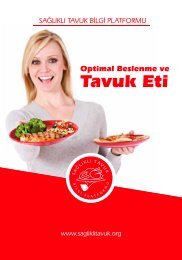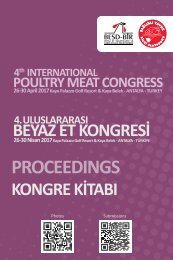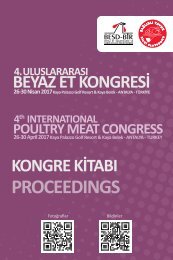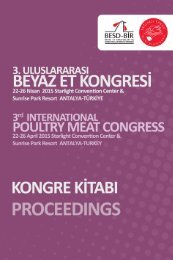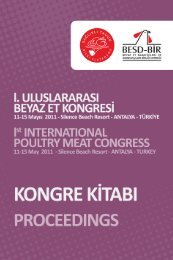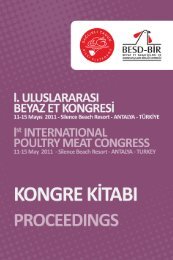3rd International Poultry Meat Congress
Proceedings
Proceedings
Create successful ePaper yourself
Turn your PDF publications into a flip-book with our unique Google optimized e-Paper software.
intestine and overcome the physiological limitations due to the delayed access to feed after posthatch<br />
period (3). According to this method, nutrient solutions are directly inserted to amniotic<br />
fluid to deliver essential nutrient to intestine before hatch. Previous studies have shown that<br />
many nutrient, such as carbohydrates (4,5,6), vitamin and minerals (7), can be incorporated to<br />
amnion during the last quarter of the incubation. In addition, recent studies have demonstrated<br />
that, probiotics, prebiotics and synbiotics could be administered to chick eggs that contain viable<br />
embryo. Enterococcus faecium, a lactic acid bacterium and normal inhabitant in the gut, is a<br />
probiotic that may be useful in animal health (8,9). Intra-amniotic E. faecium inoculation to the<br />
eggs and its presence and viability in chicks’ ceca was clear demonstrated by De Oliveira et al.<br />
(1). In addition they revealed that Salmonella Enteritidis was decreased by the in ovo E. faecium<br />
administration and continued receiving it in the diet (1).<br />
Inulin is a mixture of linear polymers and oligomers of fructose linked by a β(2—1) glycosidic<br />
linkage (10). Because of the configuration, inulin is not hydrolysed by digestive enzymes and<br />
positively affect the host by selectively stimulating the growth and activity of one or limited<br />
number of bacteria in the intestine (10). Previous studies have revealed that the dietary prebiotics<br />
may increase the intestinal beneficial bacteria population (11), alter the cecal microbial activity<br />
(12), and improve the gut integrity (13), and digestibility of proteins and fats in a maizesoybean<br />
meal based diet of broiler chickens (14). In addition, it has been showed that in ovo<br />
inulin (15) and mannan oligosaccharide (16) inclusion has beneficial effect on gastrointestinal<br />
functionality and development. The importance of early established beneficial microflora in<br />
the chicken intestine and its beneficial effect on intestinal health has long been known. Based<br />
on the suggested favorable effects of intra-amniotic probiotic or prebiotic administrations, we<br />
hypothesized that in ovo synbiotic inclusion and continued receiving it in the diet may be an<br />
effective way to maintain the intestinal epithelium integrity and cecum microflora of broiler<br />
chickens from 0 to 21 days of age.<br />
Material and Methods<br />
Experiment 1<br />
Incubation Procedures and In Ovo Administration<br />
A total of 900 eggs (Ross 308) were obtained from a 33 wk old maternal flock in a commercial<br />
hatchery (Beypiliç A.Ş., Bolu, Turkey). At arrival, all the eggs were individually weighted and<br />
573 eggs with an average weight of 59.48 ± 2.54 g (Mean ± SD) were selected to place the<br />
incubator. The eggs were divided into 6 flats of 12 trays of incubator. Each tray contains 8<br />
individual rows which holds 6 eggs with similar average egg weights per row. The eggs were<br />
incubated under standard conditions. Prior to the injection, at 17 th d of incubation (E17), the eggs<br />
were candled and those unfertilized or with dead embryos were discarded and total of 510 eggs<br />
containing viable embryos were divided into 3 groups of 170 eggs each. At the day of injection<br />
eggs were removed from the incubator, candled and marked on the side of the egg to locate the<br />
amnion. The eggs were disinfected and then a hole was punched into the shell at the side of aircell<br />
chamber with a sterile 21-gauge needle. The first group was not injected and served as a<br />
negative control (NC). Second group was injected with 0.9% NaCI and served as positive control<br />
(PC). The last group was injected with 0.5% inulin (Orafti IPS, Beneo, Oreye, Belgium) and 1<br />
x 10 6 Enterococcus faecium NCIMB 10415 (Cylactin ME20, DSM Nutritional Products, Basel,<br />
Switzerland) containing solutions (Table 1). The eggs were injected with specific solutions, at<br />
the volume of 0.6 mL, with self-refilling syringes (Socorex, Ecublens, Switzerland). All eggs<br />
175




